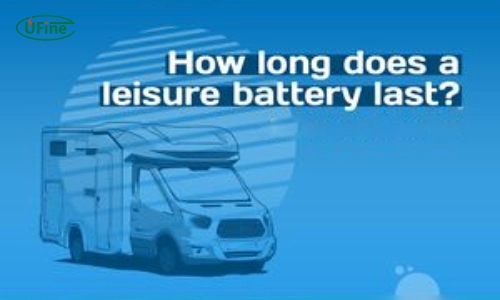Leisure batteries are crucial in powering various electrical appliances and systems in caravans, motorhomes, boats, and other recreational vehicles. Understanding the lifespan of a leisure battery is essential for efficient use and proper maintenance. In this article, we will explore the factors that affect the lifespan of a leisure battery, discuss different types of batteries and their lifetimes, provide tips on prolonging battery life, and highlight signs that indicate a shortened battery lifespan.
Part 1. Factors affecting leisure battery lifespan
The lifespan of a leisure battery can vary depending on several factors. It’s essential to consider these factors to optimize the battery’s longevity.
- Quality of the Battery: The quality and construction of the leisure battery significantly impact its lifespan. Batteries manufactured using high-quality materials and advanced technologies tend to last longer than those of lower quality.
- Battery Type: Different types of leisure batteries have varying lifespans. The most common types include lead-acid, gel, and AGM (Absorbent Glass Mat) batteries. Each type has its own unique characteristics and corresponding lifespan.
- Battery Capacity: The capacity of a leisure battery, measured in ampere-hours (Ah), determines how long it can power your appliances before requiring recharging. Higher capacity batteries typically last longer, as they can store more energy.
- Depth of Discharge (DoD): Extensively draining the battery through deep discharges can reduce its lifespan. Shallow discharges, on the other hand, are less taxing on the battery and help prolong its overall lifespan.
- Charging Method and Maintenance: Proper charging methods and regular maintenance routines are crucial for maximizing the lifespan of a leisure battery. Overcharging, undercharging, or prolonged periods of disuse can all impact the battery’s longevity.
Part 2. Different types of leisure battery lifetimes
Understanding the lifetimes of different types of leisure batteries can help you make an informed decision when selecting one for your specific needs. Let’s explore the various types and their respective lifespans:
1. Lead-Acid Batteries
Lead-acid batteries are the most common and widely used type in leisure applications. They are affordable and offer a moderate lifespan of approximately 3 to 5 years, depending on usage and maintenance. Regularly checking and topping up the electrolyte levels can help extend their lifespan.
2. Gel Batteries
Gel batteries are a more advanced alternative to lead-acid batteries. They are sealed and maintenance-free, providing better resistance to vibration and deep discharge. Gel batteries typically last 5 to 7 years, making them popular for leisure applications.
3. AGM (Absorbent Glass Mat) Batteries
AGM batteries are known for superior performance and durability. They use a special mat that holds the electrolyte, making them spill-proof and vibration-resistant. AGM batteries can handle deep discharges without significant damage and range from 7 to 10 years, making them a long-lasting option for leisure use.
4. Lithium-Ion Batteries
Lithium-ion batteries are a newer and increasingly popular choice for leisure applications. They offer several advantages, including higher energy density, lighter weight, and longer lifespan. Lithium-ion batteries can last 10 to 15 years, providing an extended lifespan compared to other battery types. However, they are usually more expensive upfront.
Part 3. How do you prolong the lifespan of your leisure battery?
To maximize the lifespan of your leisure battery, consider implementing the following tips:
- Proper Charging: Use a suitable charger for your battery type. Avoid overcharging or undercharging, as both can negatively impact the battery’s lifespan. Follow the manufacturer’s recommendations for charging voltage and current.
- Avoid Deep Discharges: Whenever possible, avoid deep discharges that can strain the battery. Aim for shallow discharges and promptly recharge the battery to minimize stress and prolong its lifespan.
- Regular Maintenance: Regularly inspect the battery for signs of damage, corrosion, or leaks. Clean the terminals and ensure they are tightly connected. If using a lead-acid battery, check and top up the electrolyte levels as necessary.
- Temperature Considerations: Extreme temperatures can affect battery performance and lifespan. Avoid exposing the battery to excessive heat or cold. If storing the battery during winter, ensure it is charged and kept in a cool, dry place.
- Equalization Charging (for Lead-Acid Batteries): Periodically perform equalization charging for lead-acid batteries. This process helps balance the voltage of individual cells and prevents sulfation, a common cause of battery failure. Follow the manufacturer’s instructions for proper equalization charging.
Part 4. Leisure battery signs of shortened life
As a leisure battery nears the end of its lifespan, several signs may indicate that it requires replacement:
- Reduced Capacity: If your battery no longer holds a charge for as long as it used to, it may be a sign of diminished capacity. This indicates that the battery is nearing the end of its usable life.
- Difficulty Holding a Charge: If the battery struggles to retain a charge or discharges quickly even after a full charge, it may be a sign of internal damage or aging.
- Swollen or Leaking Battery Case: Physical deformities, such as a swollen or leaking battery case, are clear indications of battery deterioration. Such damage can compromise the battery’s performance and safety.
- Increased Self-Discharge: If the battery discharges more rapidly when not in use, it may indicate increased self-discharge. This can occur as the battery ages and loses its ability to retain stored energy.
- Difficulty Starting Appliances: If your leisure battery struggles to power appliances that used to run smoothly, it could be a symptom of a weakened battery nearing the end of its lifespan.
Part 5. FAQs
-
How long will a leisure battery last before charging?
The duration a leisure battery lasts before needing recharging depends on factors such as its capacity, the power consumption of connected devices, and how frequently you use it. Generally, a leisure battery can last anywhere from a few hours to several days before requiring recharging. -
How do you charge the leisure battery from the main hook-up?
Charging a leisure battery from a mains hook-up is simple. First, ensure you have a compatible mains charger for your battery type. Then, connect the charger to the mains power supply and plug it into your leisure battery, following the manufacturer’s instructions. Allow the battery to charge fully before disconnecting the charger. -
How do you use a leisure battery when camping?
First, ensure you fully charge a leisure battery before using it for camping. Then, connect your camping equipment, such as lights, a fridge, or a portable stove, to the battery using appropriate cables and connectors. Use the equipment as you would at home, being mindful of the battery’s charge level and conserving power when necessary. -
How long will a leisure battery last with an inverter?
The duration a leisure battery lasts with an inverter depends on factors such as the battery’s capacity, the power consumption of the devices connected to the inverter, and how efficiently the inverter operates. Generally, a leisure battery can power small electronic devices for several hours to a day when used with an inverter. Still, larger appliances may drain the battery more quickly.
Related Tags:
More Articles

Where to Find the Right 18650 Battery Wholesale?
Discover how to choose a reliable 18650 battery wholesale supplier, compare prices, ensure safety, and avoid common buying mistakes.
18650 Battery Short Circuit: Risks and Safety Tips
Discover what happens during a 18650 battery short circuit, warning signs, and how to avoid fire, damage, and hazardous failures in your devices.
LiPo Battery Discharge Rate Guide & Calculation Tips
Understand LiPo battery discharge rates, C-ratings, and how to calculate max current. Essential guide for RC, drones, and electronics users.
High‑Capacity 3S LiPo Batteries: 5000 mAh vs. 10000 mAh
Compare 3S LiPo 5000mAh vs 10000mAh batteries by weight, power, and use. Find the best fit for your drone, RC car, or boat setup.
Top 5 Applications for Small 3S LiPo Batteries
Small 3S LiPo batteries power drones, RC gear, wearables, and robotics with high energy and low weight. Making them ideal for compact electronics projects.




